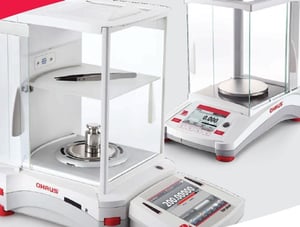Tips to Help You Keep Your Scales Calibrated
When you rely on an Ohaus brand scale in your workspace or lab, you count on it to deliver accurate readings and numbers. Your health, or the health of your customers, might very well depend on the results you use from your scale’s readout. However, unlike more traditional scales, scale calibration for Ohaus models isn’t an easy feat; their level of precision requires an equal level of expertise to ensure calibration results are trustworthy and do not damage the inner mechanisms—an expensive mistake to make.
 Calibrating Ohaus Analytical and Precision Balances
Calibrating Ohaus Analytical and Precision Balances
These types of scales are typically stationary, and are placed in an area that materials are brought over to, rather than vice versa. With that in mind, calibration might naturally get put on the “back Bunsen burner,” as it were, under the mistaken belief that lack of scale movement equals stable mechanisms. Vibrations and use alone can misalign a scale over time; even with larger, stationary units like Ohaus’ analytical and precision balances. Calibrating an Ohaus scale like the electronic-readout model Scout® starts with following the included manufacturer’s instructions for “flashing” the calibration—a process that involves setting a specific weight on the scale at a specific time to help realign its sensors. This doesn’t always work, however, which is why it’s important to schedule regular calibration and maintenance through a professional.
Calibrating Compact Ohaus Scales
Smaller “traveling” scale units are far more prone to miscalculations than their larger cousins. Bumps, drops, and three-dimensional movement are all a precision mechanism’s worst enemy, which is why it’s especially important to calibrate these scale types often. Again, if your compact scale is an electronic version, you’re fortunate in that a built-in process is available to help you flash calibrate, though you will need to have the appropriate precision weights on hand. To avoid misalignment, always handle your compact scale carefully, and store it in an area that isn’t regularly exposed to extreme temperatures or vibrations.
Calibrating Ohaus Triple Beam Balances
If you own a triple beam-style balance from Ohaus, you can manually adjust it to a point with precision weights, but it’s best to leave it—or take it—to a professional for scale service. The springs and counter-weights in these scale styles are especially delicate. Fortunately, service providers are readily available; this style of scale is frequently used in retail applications like grocery stores.
No matter which type of Ohaus scale you own or use, calibration is an integral part of getting accurate, trustworthy readings. Don’t neglect examining and servicing your scales, and you’ll always have a steady stream of reliable numerical data for all of your important applications.
Finding a Service Provider
You’ll want to find a service provider that offers comprehensive calibration services in accordance with the most recent ASI/ASTM, National Bureau of Standards, and the National Institute of Standards and Technology (NIST) specification. At Alliance Scale, we adhere to these standards—and all service is performed either on-site or in our lab, using various classes of test weights. We’re happy to work with you and get your vital equipment properly calibrated. Schedule our weight calibration service now!



